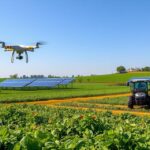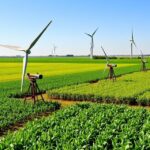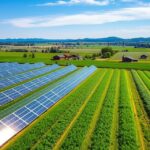Did you know that nearly 40% of global food production goes to waste? Spoilage is a major cause. Solar drying offers an innovative solution to this problem.
Sustainable agriculture is changing how farmers preserve food. DIY solar dryers extend crop shelf life while using less energy. They also reduce environmental impact.
These clever devices use sunlight to dry fruits, vegetables, and herbs. Farmers and gardeners can cut food waste with solar drying. They can also make long-lasting, nutritious preserved foods.
Solar dryers are simple and sustainable. They offer an eco-friendly option to traditional preservation methods. Anyone can build a solar drying system with basic skills and minimal equipment.
This guide explores DIY solar dryers in depth. You’ll learn how renewable crop preservation can be easy and affordable. It can also transform communities seeking new farming solutions.

Introduction to DIY Solar Dryers
DIY solar dryers offer an eco-friendly way to preserve food. These devices use sunlight to turn fresh produce into long-lasting, nutrient-rich dried foods. They’re perfect for farmers and home gardeners alike.
Solar food dehydration goes beyond simple preservation. It reduces waste and creates tasty, shelf-stable products using only sunlight and smart design.
What are Solar Dryers?
Solar dryers use the sun’s energy to remove moisture from fruits, vegetables, and herbs. They offer several advantages over traditional drying methods.
- Protect food from insects and dust
- Maintain consistent temperatures
- Accelerate the drying process
- Preserve nutritional value
Benefits of Solar Drying
DIY solar dryers offer more than just food preservation. They provide significant environmental and economic benefits.
| Benefit Category | Specific Advantages |
|---|---|
| Environmental Impact | Zero electricity consumption, reduced carbon footprint |
| Economic Savings | Low-cost construction, minimal operational expenses |
| Food Quality | Retained nutrients, enhanced flavor concentration |

Understanding Renewable Energy in Agriculture
Renewable energy is changing how we farm. Solar food dehydration shows how sustainable tech can improve traditional farming methods. It offers efficient, eco-friendly solutions for crop preservation.
“Solar dryers represent the intersection of innovation, sustainability, and practical food preservation techniques.” – Sustainable Agriculture Research Institute
How Solar Drying Works
Solar drying harnesses sunlight to preserve crops efficiently. This innovative method offers sustainable food preservation for farmers worldwide. Off-grid drying revolutionizes crop management for small-scale producers.
The Science Behind Solar Drying
Solar drying relies on three key principles of heat transfer and moisture removal:
- Solar radiation generates heat within the drying chamber
- Warm air circulates to extract moisture from crops
- Ventilation systems promote efficient dehydration
Types of Solar Drying Techniques
Farmers can choose from various solar drying methods based on their needs. Each technique offers unique benefits for renewable crop drying.
| Drying Method | Characteristics | Best For |
|---|---|---|
| Direct Solar Drying | Crops exposed directly to sunlight | Herbs, spices, fruits |
| Indirect Solar Drying | Heated air circulates around crops | Vegetables, grains |
| Hybrid Solar Drying | Combines solar energy with auxiliary heat sources | Large-scale agricultural operations |
“Solar drying transforms agricultural preservation by providing an eco-friendly, cost-effective solution for crop management.” – Sustainable Agriculture Research Institute
Off-grid drying empowers farmers to preserve harvests without expensive electrical infrastructure. These techniques help maximize crop value while reducing environmental impact.
Designing Your Own Solar Dryer
Building a solar dehydrator is a fun project for sustainable food preservation. It’s an affordable way to dry fruits, veggies, and herbs using the sun’s energy. DIY solar dryers are eco-friendly and cost-effective.
Understanding key components and design principles is vital before starting your solar dryer project. These devices use solar energy to turn fresh produce into long-lasting dried goods.
Essential Materials for Construction
Gathering the right materials is crucial for building effective solar dryers. You’ll need:
- Wooden boards or plywood
- Clear polycarbonate or glass sheets
- Black paint or aluminum foil
- Mesh screens
- Hinges and screws
- Thermometer
Building Your Homemade Solar Dehydrator
Creating DIY solar dryers requires careful planning and attention to detail. Follow these general steps:
- Create a sturdy wooden frame
- Design an angled solar collection area
- Install ventilation passages
- Add removable drying racks
- Paint interior surfaces black to absorb heat
Safety Considerations
When building solar dryers, focus on safety and functionality. Ensure proper ventilation and use heat-resistant materials. Monitor internal temperatures and keep the dryer away from flammable items.
“A well-designed solar dryer can transform how we preserve food, making it both sustainable and efficient.” – Renewable Energy Expert
With patience and creativity, you can build a robust solar dehydrator. It will change your food preservation methods and reduce energy use.
Choosing the Right Crops for Solar Drying
Solar food dehydration extends harvest life using renewable energy. It helps farmers and gardeners reduce food waste. Choosing the right crops maximizes sustainable agriculture efforts.
Not all produce dries equally in solar dehydrators. Moisture content, thickness, and natural sugar levels matter. Careful crop selection is key for successful solar drying.
Ideal Crops for Solar Drying
- Herbs: Basil, thyme, rosemary
- Fruits: Apples, bananas, berries, peaches
- Vegetables: Tomatoes, peppers, onions, carrots
- Medicinal plants: Chamomile, mint, lavender
Seasonal Crop Drying Considerations
Solar food dehydration success depends on seasonal changes. Different crops dry best at specific times. Regional climate affects optimal drying periods.
| Season | Recommended Crops | Drying Difficulty |
|---|---|---|
| Summer | Tomatoes, Peppers | Easy |
| Fall | Apples, Squash | Moderate |
| Spring | Herbs, Leafy Greens | Simple |
“Renewable crop preservation isn’t just about saving food—it’s about creating sustainable agricultural practices that benefit both farmers and the environment.” – Agricultural Sustainability Research Institute
Effective solar drying requires understanding crop characteristics. This knowledge helps create a strategy that preserves more food. It also reduces waste in the process.
Preparing Crops for Solar Drying
Careful crop preparation is key to successful solar drying. It requires attention to detail and eco-friendly food preservation methods. Proper prep ensures high-quality dried products and supports sustainable agriculture.
Essential Cleaning Techniques
Crop cleaning is crucial for solar drying. It removes dirt, debris, and contaminants to ensure food safety and quality. Here are the key cleaning steps:
- Rinse crops thoroughly with clean water
- Remove any damaged or bruised sections
- Use food-safe sanitizing solutions for additional protection
- Pat dry with clean towels or air dry completely
Optimal Cutting Methods
Cutting techniques greatly affect the drying process. Uniform slice size ensures consistent drying and prevents moisture retention.
| Crop Type | Recommended Cutting Technique | Ideal Slice Thickness |
|---|---|---|
| Tomatoes | Thin, even slices | 1/4 inch |
| Herbs | Whole leaves or fine chop | 1/8 inch |
| Fruits | Uniform circular or half-moon cuts | 1/2 inch |
“Precision in preparation transforms good crops into exceptional dried products.” – Solar Drying Expert
Different crops need unique approaches. Try various cutting techniques to find the best method for each produce type. This will help you perfect your solar drying project.
Operating Your Solar Dryer
DIY solar dryers offer a powerful off-grid method for preserving food and crops. Successful solar food dehydration requires careful monitoring and a strategic approach. This ensures optimal results and prevents spoilage.
Effective operation of solar dryers depends on understanding key environmental factors. Temperature and humidity control are critical for maintaining food quality. These factors greatly impact the drying process.
Temperature Monitoring Strategies
Tracking temperature is essential in solar food dehydration. Ideal drying temperatures typically range between 95-145°F. The specific temperature depends on the crop being processed.
- Use digital thermometers for accurate readings
- Place sensors at multiple points within the DIY solar dryers
- Check temperatures every 2-3 hours during daylight
Humidity Control Techniques
Managing moisture levels prevents bacterial growth in off-grid drying methods. It also ensures consistent drying throughout the process.
| Crop Type | Ideal Humidity Range | Drying Time |
|---|---|---|
| Herbs | 30-40% | 1-3 days |
| Fruits | 20-30% | 2-4 days |
| Vegetables | 15-25% | 3-5 days |
“Successful solar drying is an art of patience and precision” – Agricultural Preservation Expert
Best Practices for Efficient Drying
- Clean and prepare crops thoroughly before drying
- Arrange items in single layers for consistent air circulation
- Rotate trays periodically for uniform drying
- Protect dryer from direct wind and unexpected moisture
Mastering these techniques will transform your DIY solar dryers into efficient food preservation tools.
Maintaining Your Solar Dryer
Proper maintenance is vital for efficient DIY solar dryers. Regular care ensures optimal performance and food preservation quality. This keeps your equipment running smoothly and extends its lifespan.
Maintaining solar dryer designs involves key steps. These help prevent issues and maximize effectiveness. Let’s explore essential maintenance tasks and troubleshooting tips.
Regular Maintenance Tasks
- Clean the solar dryer after each use to remove debris and food particles
- Inspect seals and joints for potential wear or damage
- Check mesh screens for tears or deterioration
- Lubricate moving parts annually
- Verify glass or plastic covering remains transparent and undamaged
Troubleshooting Common Issues
DIY solar dryers can face predictable challenges. These issues require strategic solutions to keep your dryer working effectively.
| Issue | Potential Solution |
|---|---|
| Uneven drying | Adjust rack positioning and ensure proper air circulation |
| Moisture buildup | Increase ventilation and check for proper sealing |
| Temperature inconsistency | Reposition solar dryer or add reflective surfaces |
“A well-maintained solar dryer is the key to successful food preservation and sustainable agriculture.” – Sustainable Living Expert
Regular inspection helps homemade solar dehydrators perform consistently. This ensures reliable food preservation. With proper care, you can effectively preserve your harvest year-round.
Efficiency Tips for Solar Drying
Solar drying techniques are vital for sustainable agriculture. They offer farmers an innovative way to preserve crops. These methods need careful planning and execution to be effective.
Efficient solar drying strategies can greatly improve crop preservation quality. They also help reduce energy use. Learning key optimization methods helps farmers get the best results.
Maximizing Sun Exposure
Good solar drying depends on smart positioning and sun tracking. Farmers can boost their drying efficiency through targeted approaches.
- Position solar dryers at a 15-30 degree angle facing south
- Use reflective surfaces to increase heat absorption
- Install adjustable mounting systems for seasonal variations
- Clear surrounding areas of shade-producing vegetation
Timing Your Drying Process
Precise timing is crucial in solar drying for sustainable farming. Farmers should think about these key timing strategies:
| Time of Day | Recommended Action |
|---|---|
| Early Morning | Prepare and arrange crops for initial drying |
| Peak Sunlight Hours | Maximum solar exposure and heat generation |
| Late Afternoon | Monitor moisture levels and adjust positioning |
“Efficient solar drying is an art of understanding sunlight, temperature, and crop characteristics.” – Agricultural Research Institute
Using these advanced solar drying techniques can improve crop preservation. Farmers can optimize their process while embracing sustainable practices. This approach benefits both the environment and their harvests.
Innovative Solar Drying Solutions
Groundbreaking solar dryer designs are transforming sustainable agriculture. Advanced technologies are pushing the boundaries of efficient harvest preservation. These innovations minimize environmental impact while boosting crop preservation.
Modern solar drying solutions are revolutionizing crop preservation across industries. These cutting-edge technologies offer unmatched efficiency and sustainability. Agricultural producers benefit greatly from these advancements.
Commercial Solar Drying Technologies
Commercial solar drying technologies have made significant strides recently. Key innovations have emerged in this field.
- Hybrid solar-electric drying systems
- Automated temperature control mechanisms
- Large-scale modular solar drying units
- Smart monitoring technologies
Case Studies on Successful Implementations
Researchers and agricultural experts have documented impressive results worldwide. Solar drying implementations have shown promising outcomes in various regions.
| Region | Crop Type | Solar Drying Method | Efficiency Improvement |
|---|---|---|---|
| California, USA | Fruits and Nuts | Advanced Greenhouse Solar Dryer | 45% Energy Savings |
| Kenya | Vegetables | Community Solar Drying Center | 60% Reduced Food Waste |
| India | Spices | Integrated Solar Tunnel Dryer | 50% Faster Drying Time |
“Solar drying represents the future of sustainable crop preservation, offering an eco-friendly alternative to traditional drying methods.” – Agricultural Innovation Institute
Solar dryer designs continue to expand in renewable crop preservation. Sustainable agriculture is now a practical reality for farmers worldwide. These innovations are shaping the future of agricultural practices.
Environmental Impact of Solar Drying
Solar drying is a game-changing method for crop preservation. It uses natural energy to transform food processing. This innovative technique offers major environmental benefits for sustainable agriculture.
Solar drying does more than just preserve food. It’s an eco-friendly method that greatly reduces carbon footprint. It also tackles important agricultural challenges.
Reducing Food Waste Through Innovative Techniques
Food waste is a worldwide issue with big environmental effects. Solar drying offers a smart solution to this problem.
- Extending crop shelf life by 6-12 months
- Minimizing post-harvest losses
- Preserving nutritional value without chemical treatments
“Solar drying transforms agricultural waste management by creating sustainable preservation pathways.” – Agricultural Sustainability Research Institute
Contribution to Sustainable Agricultural Practices
Sustainable farming needs new ideas that are gentle on the environment. Solar drying is a key strategy for this goal.
- Reducing energy consumption in food processing
- Decreasing reliance on fossil fuel-powered preservation methods
- Supporting small-scale farmers with low-cost technology
By integrating solar drying techniques, farmers can significantly reduce their carbon emissions while improving food security and economic resilience.
Conclusion
DIY solar dryers offer a powerful solution for renewable crop preservation. They empower farmers and gardeners across the United States. These devices provide an eco-friendly alternative to traditional drying methods.
Solar dryers harness clean energy to transform food preservation. They reduce energy use and environmental impact. This approach supports sustainable agriculture practices.
The Future of Renewable Crop Preservation
DIY solar dryers have potential beyond individual projects. They could revolutionize community food preservation. Small-scale farmers can reduce waste and extend crop storage.
These simple technologies create more resilient local food systems. They promote sustainable agricultural practices. As awareness grows, more communities may adopt these methods.
Encouragement for DIY Projects
Building a solar dryer requires little investment but offers big rewards. It’s accessible for home gardeners and small-scale farmers alike. The project can be a rewarding and educational experience.
These projects improve personal food preservation skills. They also contribute to broader sustainable agriculture efforts. Start small and watch how this technology transforms your approach.
DIY solar dryers can impact local food ecosystems. Experiment with this simple technology. You’ll see how it enhances crop preservation and environmental stewardship.
FAQ
What exactly is a solar dryer?
A solar dryer is a device that uses sunlight to remove moisture from food and crops. It creates heat and airflow to preserve food through controlled dehydration. This eco-friendly method doesn’t use electrical power.
How do solar dryers differ from traditional food dehydrators?
Solar dryers use renewable energy, unlike electrical dehydrators. They’re more environmentally friendly and have no operating costs. These dryers can be built with simple, local materials.
They’re great for rural or off-grid areas with lots of sunlight.
What types of crops work best for solar drying?
Fruits like apples, bananas, mangoes, and berries dry well in solar dryers. Herbs, vegetables, and some meats can also be preserved this way. Foods with low moisture and high sugar content dry more effectively.
How long does it take to dry food using a solar dryer?
Drying time varies based on the crop, temperature, humidity, and sunlight intensity. Most foods take between 6 to 48 hours to dry completely. Thin-sliced fruits might dry in 6-12 hours.
Thicker items could take up to two days.
Are homemade solar dryers difficult to construct?
DIY solar dryers are simple to build using basic materials. You’ll need wooden frames, glass or plastic covers, metal screens, and black paint. Many designs are available online for different skill levels.
What are the primary benefits of solar drying?
Solar drying offers zero energy costs and reduces food waste. It preserves nutritional value and is environmentally friendly. This method doesn’t need electrical infrastructure and extends crop shelf life for months.
How do I ensure food safety when solar drying?
Clean crops and equipment before drying. Slice foods evenly and keep temperatures above 135°F to prevent bacteria growth. Store dried foods in airtight containers in cool, dry places.
Regular monitoring during drying is crucial.
Can solar dryers work in cloudy or cold climates?
Solar dryers work best in sunny areas. Modified designs with extra heating can work in less ideal climates. Good positioning, insulation, and reflective surfaces help capture more solar energy.
What maintenance is required for a solar dryer?
Clean drying trays and check for damage regularly. Ensure proper sealing and inspect screens and covers for wear. Repaint heat-absorbing surfaces yearly and lubricate moving parts for better longevity.
Are solar dryers cost-effective for small-scale farmers?
Solar dryers are very cost-effective for small-scale farmers. They need little upfront investment and have no operating costs. This technology helps farmers reduce crop losses and create valuable dried products.






